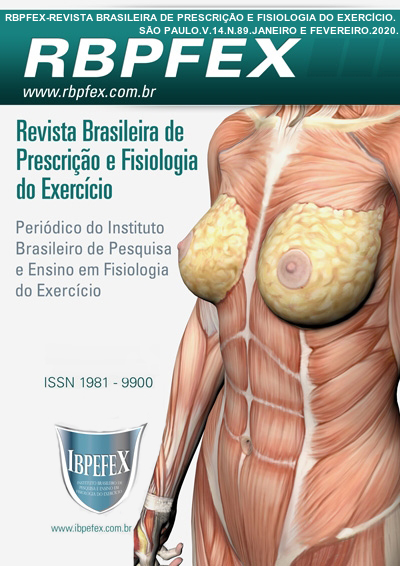Heart rate variability and strength training in individuals with cardiovascular diseases: a systematic review
Abstract
Purpose: To investigate the positive effects of strength training in individuals with cardiovascular disease through heart rate variability (HRV) behavior. Methods: This is a review study, oriented according to the PICOS. Methods: A review of the literature was performed through 136 articles available in two databases considered to be of great scientific relevance: Medline, Pubmed, published from 2005 to 2016. Results: The analyzed literature demonstrates that after completing the strength training program, there was an increase in all variables used for HRV analysis, indicating a change in autonomic modulation, although, in some studies, such changes were not statistically significant. Conclusion: Strength training can promote significant effects in relation to autonomic modulation exerted on the cardiac system in individuals with cardiovascular disease.
References
Afonso, C. O. acidente vascular cerebral e a força muscular: estudo de revisão. Rev. Med. Desp. Informa. Lisboa. Vol.3 Num.3.2012. p.19-21.
Bernardo, W. M.; Nobre, M. R.; Jatene, F. B. Evidence-based clinical practice. Part II-Searching evidence databases. Rev Assoc Med Bras. Vol. 50. Num 1. 2004. p.104-8.
Figueiredo, T.; Rhea, M. R.; Peterson, M.; Miranda, H.; Bentes, C. M.; Reis, V. M. M.R.; Simão, R. Influence of number of sets on blood pressure and heart rate variability after astrength training session. J Strength Cond Res. Vol. 29. Num. 5. 2015. p. 1556-63.
Fronchetti, L.; Nakamura, F.; Aguiar, C.; Oliveira, F. Indicadores de regulação autonômica cardíaca em repouso e durante exercício progressivo: Aplicação do limiar de variabilidade da frequência cardíaca. Rev. Port. Cien. Desp. Vol.6. Num.1. 2006. p.21-28.
Giada, F.; Biffi, A.; Agostini, P.; Anedda, A.; Belardinelli, R.; Carlon, R.; Caru, B.; D’andrea, L.; Delise, P.;Francesco, A.; Fattirolli, F.; Guglielmi, R.; Guiducci, R.; Pelliccia, A.; Penco, M.; Perticone, F.; Thiene, G.; Vona, M.; Zeppilli, P. Exercise prescription for the prevention and treatment ofcardiovascular diseases: Rev. J Cardiovasc Med. Vol. 9. 2008. p. 641-652.
Lopes, F. L.; e colaboradores. Redução da variabilidade da frequência cardíaca em indivíduos de meia-idade e o efeito do treinamento de força. Revista Brasileira de Fisioterapia. São Carlos. Vol. 11. Num. 2. 2007. p. 113-119.
Menezes, R. Dificuldades enfrentadas pela equipe de enfermagem no atendimento aparada cardiorrespiratória. Rev. Inter Scientia. Vol.1. Num.3. 2013. p.2-15.
Rezk, C. C.; Marrache, R. C.; Tinnucci, T.; Mion, D. Jr.; Forjaz, C. L. Post-resistance exercise hypotension, hemodynamics, and heart rate variability: influence of exercise intensity. Eur J Appl Physiol. Vol. 98. Num. 1. 2006. p. 105-112.
Ruiz, J. R.; Sui, X.; Lobelo, F.; Morrow, J. R.; Jackson, A. W.; Sjo ̈Stro ̈M, M.; Blair, S. N. Association between muscular strength and mortality in men: Rev. prospective cohort study. BMJ. p.337.2008.
Santos, C. M. C.; Pimenta, C. A. M.; Nobre, M. R. C. The PICOstrategy for the research question construction and evidence search. Rev. Latino-Am. Vol. 3. Num. 5. 2007. 1016-1023.
Silva, A. B.; Machado, R. C. Elaboração de guia teórico de atendimento em parada cardiorrespiratória para enfermeiros. Rev Rene. Vol.14. Num.4. 2013. p. 1014-1021.
Simão, R.; Fleck, S. J.; Polito, M.; Monteiro, W.; Farinatti, P. T. V. Effects of resistance training intensity, volume, and session format on the post exercise hypotensive response. J Strength Cond Res. Vol.9. Num. 4. 2005. p. 853-858.
Simão, R.; Spineti, J.; Salles, B.F.; Matta, T.; Fernandes, L.; Fleck, S.J.; Rhea, M.R.; Strom-Olsen, H. E. Comparison between nonlinear and linear periodized resistance training: Hypertrophic and strength effects. J Strength Cond Res. Vol. 26. Num. 5. 2012. p. 1389-1395.
Scher, L. M. L.; Ferriolli, E.; Moriguti, J. C.; Scher, R.; Lima, N. K. C. The effect of different volumes on acute resistance exercises on elderly individuals with treated hypertension. J Strength Cond Res. Vol. 25. Num. 4. 2011. p. 1016-1023.
Thayer, J. F; Ahs, F.; Fredrikson, M.; Sollers J. J.; Wager, T. D.A meta-analysis of heart rate variability and neuroimaging studies: implications for heart rate variability as a marker of stress and health. Neurosci Biobehav Rev. Vol. 36. Num. 2. 2012. p. 747-756.
Thayer, J. F.; Sternberg E. Beyond heart rate variability: Vagal regulation of allostatic systems. Ann N Y Acad Sci. Vol. 1088. 2006. p. 361-372.
Vanderlei, L. C. M.; Pastre, C. M.; Hoshi, R. A.; Carvalho, T. D.; Godoy, M. F. Noções básicas de variabilidade da frequência cardíaca e sua aplicabilidade clínica. Rev Bras Cir Cardiovasc. Vol. 24. Num. 2. 2006. p. 205-217.
Copyright (c) 2021 Brazilian Journal of Exercise Physiology and Prescription (RBPFEX)

This work is licensed under a Creative Commons Attribution-NonCommercial 4.0 International License.
Authors who publish in this journal agree to the following terms:
- Authors retain the copyright and grant the journal the right of first publication, with work simultaneously licensed under the Creative Commons Attribution License BY-NC which allows the sharing of the work with acknowledgment of the authorship of the work and initial publication in this journal.
- Authors are authorized to enter into additional contracts separately for non-exclusive distribution of the version of the work published in this journal (eg, publishing in institutional repository or book chapter), with acknowledgment of authorship and initial publication in this journal.
- Authors are allowed and encouraged to post and distribute their work online (eg, in institutional repositories or on their personal page) at any point before or during the editorial process, as this can bring about productive change as well as increase impact and impact. citation of published work (See The Effect of Free Access).






